There is a huge push at Government and EU level to enter land into organic production. At present, approximately 2% of agricultural land in Ireland is under organics, but the aim from the EU is to increase this to 25%.
This seems straightforward to many – just stop applying fertiliser and chemical pesticides.
However, the task is far from simple and this was clear from a visit to the farm of Leo Dunne Ltd in Durrow, Co Laois, where the Irish Farmers Journal met farm manager Tim Davies.
Tim works alongside Leo’s son Emmet, who is general manager. While the task isn’t simple, it is great to see farmers venturing into different markets and embracing challenges.
The potato harvest was just getting under way during our visit at the beginning of September. The farm supplies conventional carrots to supermarkets and ventured into organic potatoes with 10ac about six years ago.
This season, that area has increased to 80ac of potatoes and a further 80ac of carrots, cabbage, broccoli, leeks, beetroot and kale. Of course, all of these crops need to run in a rotation to avoid pest damage. Approximately 200ac of organic oats are grown for Flahavan’s and there is also grass and clover in the seven-year rotation. In total, there are 425ac of vegetables on the farm.

Carrots, cabbage and leeks growing on the farm.
At present, Tim thinks that the farm is at its limit with organics, as the rewards simply aren’t there for the work involved.
“Demand can take more, but there’s a lot of work. It’s very labour-intensive. There’s a bit more management in it than just taking the sprayer out,” Tim said.
Planning for next year’s crops starts well before the previous crops are harvested. Once fields are decided upon, weed control starts by creating a stale seedbed – discing to bring up flushes of weeds. Cover crops are planted to avoid leaching and gather nitrogen over the winter months.
Tim emphasised the importance of holding on to the nitrogen through cover crops to secure good yields. Within the cover crop mixes are plants like phacelia, radish and cereals, and Tim explained that land is no longer left idle as these crops have a lot of benefits for the soil.

Carrots, cabbage and leeks growing on the farm.
“In springtime, we get in as early as we can to create stale seedbeds. That’s the only way you can really do it in organics, so we’d be in as soon as we can, usually at the end of March or early April,” he said.
If the land is being planted with potatoes, Tim said that they will destone the ground and leave planting for as long as possible. However, this is where things get complicated, as early planting can reduce blight risk – the potatoes should be stronger when blight pressure ensues – but if a frost hits, those potatoes could be wiped out. This makes stale seedbeds difficult in potatoes. With carrots it’s a different story, as the seedbeds are started in March, but the carrots aren’t planted until May. That eight-week window makes all the difference.
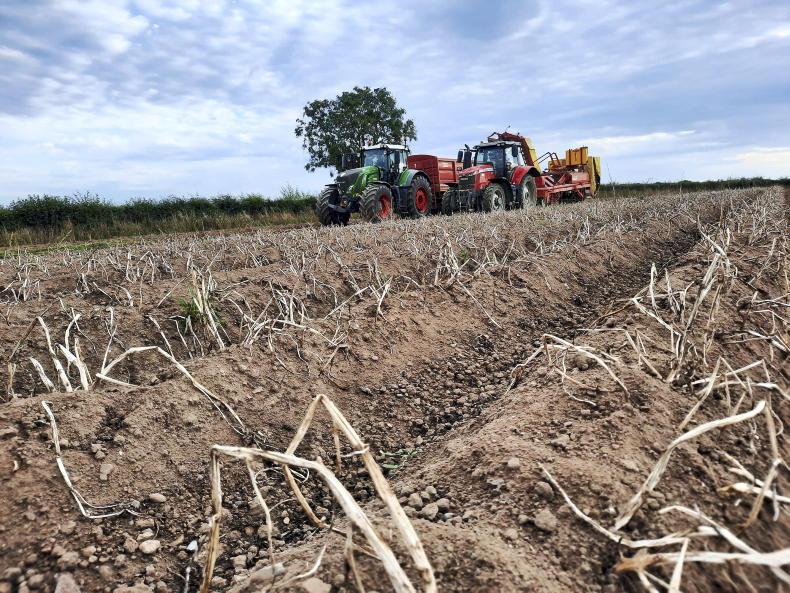
Carrots, cabbage and leeks growing on the farm.
With no access to herbicides, the gas burner is an important tool on the farm. A gas tank is mounted to the front of the tractor and Tim noted that this machine carries out the pre-emergence weed control. Flames from the burner kill the weeds.
“We run through with inter-row cultivators as well [Grimme ridging hiller]. Like what they used to do 30 years ago, we re-ridge the drills.
“Until the crop grows too tall, you can run through it two to three times. Depending on your weed burden, each field is treated separately,” Tim added.
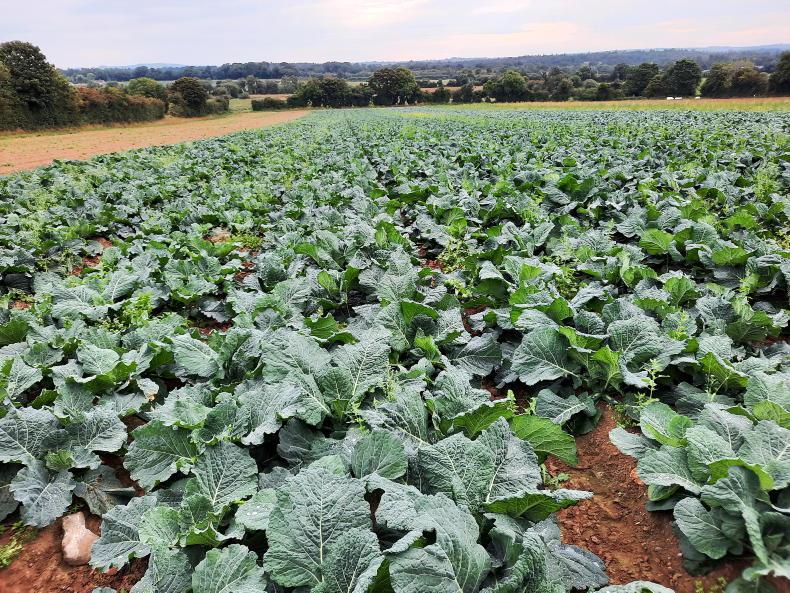
Carrots, cabbage and leeks growing on the farm.
With carrots, the burner is used twice before planting and again once the crop is planted. A robotic weeder is also used in the carrot fields and this season an investment was made in two-bed weeders which allow 15 people to hand weed at the same time. This machine also requires a huge investment in labour.
Potato blight
Of course, blight is the big worry with potatoes. In conventional systems, at certain times of the year, crops might be sprayed on a weekly basis, so the task of blight control is always going to be difficult in organics.
“Blight is the big one. This year, we’ve been very lucky. I haven’t seen any blight. We start off planting as early as we can, which would be April.

Organic potatoes being harvested for Leo Dunne Limited in Durrow, Co Laois.
“We try not to choose any small fields with trees or hedgerows all around them. We want big open spaces to promote air movement. The tilling we do reduces the movement of the blight spores.”
However, Tim noted that low nitrogen levels mean a thinner crop, which helps: “High-nitrogen plant tissue would always be more susceptible to blight. We do see that in organics and yield is lower as a consequence but the lower nitrogen means you will not see as much blight.”
Tim has three weather stations across the farm to warn when there is blight pressure coming. Copper can be applied to the crop in times of pressure, but only in small amounts.
“If there’s pressure coming on, we’re always going to have the plant protected before that pressure it arrives. That’s where I can use copper, but I’ve only got so many hits – maybe four or five.”
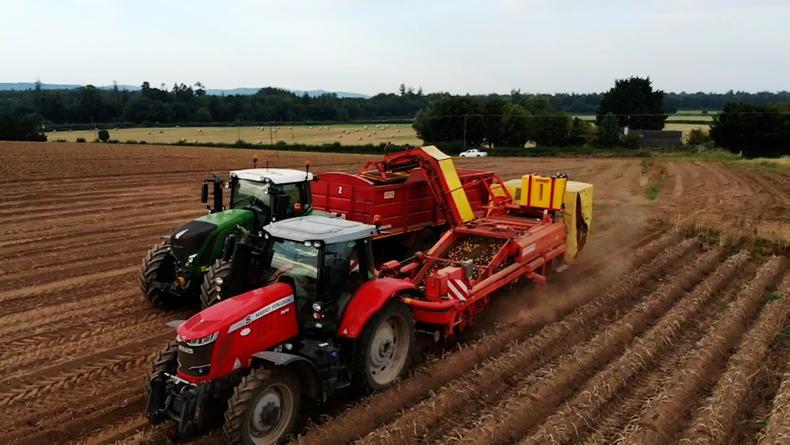
Organic potatoes being harvested for Leo Dunne Limited in Durrow, Co Laois.
Before harvest, the crop has to be desiccated. Conventional farmers are struggling without the chemical diquat and have received a derogation to use it again this season. Tim has been using a flail topper and then hitting the crop with a gas burner. So far it is working well, but we must remember Tim is using the gas burner quite a bit in this system and gas prices are currently on the rise, adding further to the crop’s bill.
Yields are the question on everyone’s mind after all of this investment. Tim said yields average 10t/ac. This compares with approximately 16-20t/ac in conventional systems. At these yields, a higher price is needed.
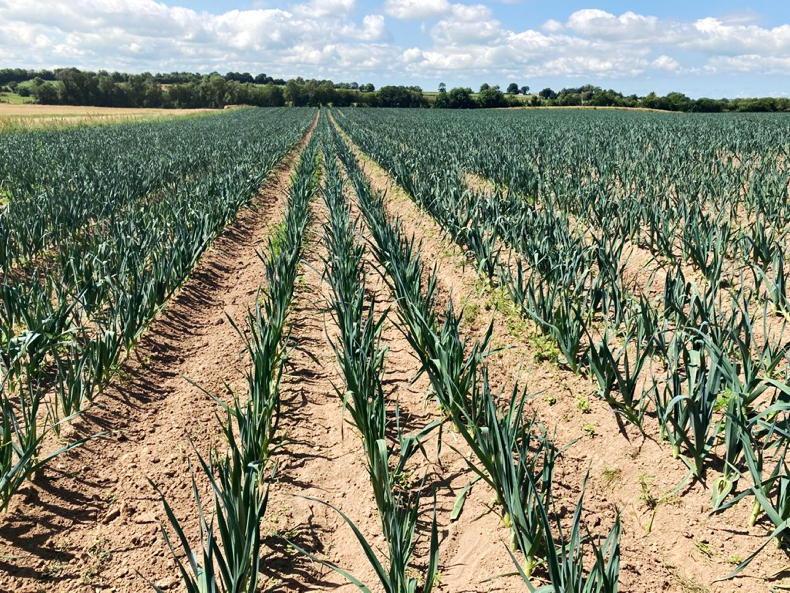
Carrots, cabbage and leeks growing on the farm.
“As fuel, transport, wages, insurance and other input costs like irrigation increase, the margin gets tighter and as yields decrease, margin is further squeezed. Consumers will generally pick up the cheapest product, regardless of farm system or country of origin. ”
It is clearly frustrating, as Tim described the year and the work that has gone into these crops, some of which suffered from the drought and one crop was damaged by hail in July.
“You’ve got the extra work. The gas burners, two or three inter-row runs for weeds and you still have to go harvest and grade. We still have the same issues as any other farmer with scab, especially this year.”

This bed weeder was a major investment on-farm and requires a lot of labour.
On the crop hit by hailstones, Tim said: “It was like a topper had driven through it they completely snapped and that left the crop really open to blight. In one field, I had to just top there and then. It was completely gone. The other ones I tried to nurse along.”
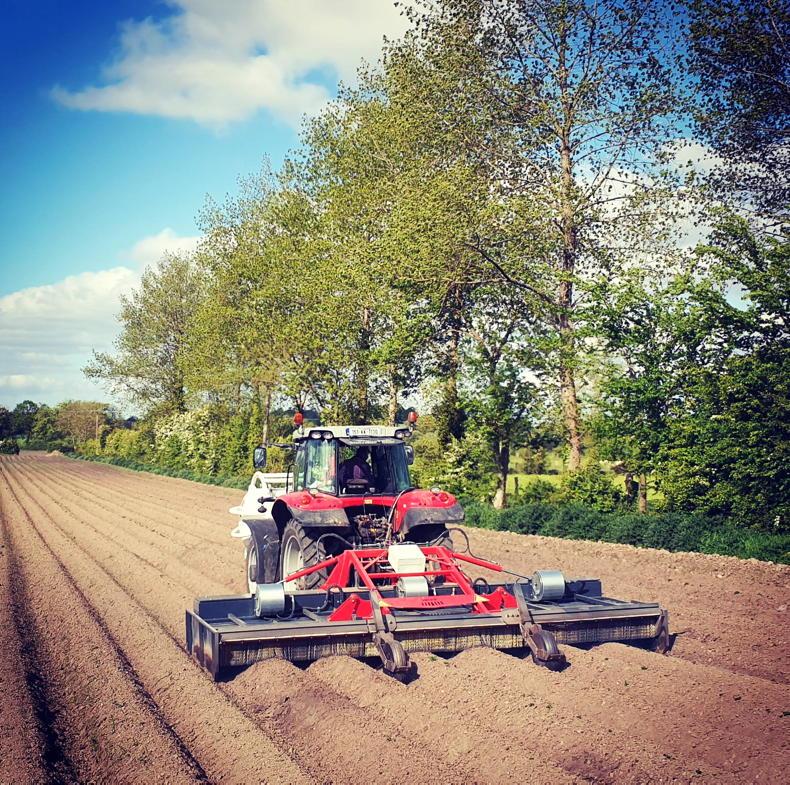
The gas burner in action to control early weeds.
It is certainly not simple and while Leo Dunne’s farm is putting huge effort into organics, the price is preventing expansion. Imports into the country are also making little of the work that goes into these crops in Ireland.
Think twice before picking up a packet of veg – the Irish suppliers need support.
Great effort, but competition
from cheap imports is a challenge
The effort put in by this farm is great to see and if the Government wants organic production to increase, large-scale farms will play a big part of this plan.
They are adapting their farm and trying to work to another market, but the competition from cheap imports makes the economics difficult.
It is important to note some of the things that are needed for organics as well. Tim explained that wide open fields reduce disease incidence and outlined the number of passes of machinery on the crop, all of which burn diesel and carbon.
There is a huge labour input as well and the past two seasons have been difficult in this regard.
It is also important not to underestimate the management from Tim as an agronomist.

There is a huge push at Government and EU level to enter land into organic production. At present, approximately 2% of agricultural land in Ireland is under organics, but the aim from the EU is to increase this to 25%.
This seems straightforward to many – just stop applying fertiliser and chemical pesticides.
However, the task is far from simple and this was clear from a visit to the farm of Leo Dunne Ltd in Durrow, Co Laois, where the Irish Farmers Journal met farm manager Tim Davies.
Tim works alongside Leo’s son Emmet, who is general manager. While the task isn’t simple, it is great to see farmers venturing into different markets and embracing challenges.
The potato harvest was just getting under way during our visit at the beginning of September. The farm supplies conventional carrots to supermarkets and ventured into organic potatoes with 10ac about six years ago.
This season, that area has increased to 80ac of potatoes and a further 80ac of carrots, cabbage, broccoli, leeks, beetroot and kale. Of course, all of these crops need to run in a rotation to avoid pest damage. Approximately 200ac of organic oats are grown for Flahavan’s and there is also grass and clover in the seven-year rotation. In total, there are 425ac of vegetables on the farm.

Carrots, cabbage and leeks growing on the farm.
At present, Tim thinks that the farm is at its limit with organics, as the rewards simply aren’t there for the work involved.
“Demand can take more, but there’s a lot of work. It’s very labour-intensive. There’s a bit more management in it than just taking the sprayer out,” Tim said.
Planning for next year’s crops starts well before the previous crops are harvested. Once fields are decided upon, weed control starts by creating a stale seedbed – discing to bring up flushes of weeds. Cover crops are planted to avoid leaching and gather nitrogen over the winter months.
Tim emphasised the importance of holding on to the nitrogen through cover crops to secure good yields. Within the cover crop mixes are plants like phacelia, radish and cereals, and Tim explained that land is no longer left idle as these crops have a lot of benefits for the soil.

Carrots, cabbage and leeks growing on the farm.
“In springtime, we get in as early as we can to create stale seedbeds. That’s the only way you can really do it in organics, so we’d be in as soon as we can, usually at the end of March or early April,” he said.
If the land is being planted with potatoes, Tim said that they will destone the ground and leave planting for as long as possible. However, this is where things get complicated, as early planting can reduce blight risk – the potatoes should be stronger when blight pressure ensues – but if a frost hits, those potatoes could be wiped out. This makes stale seedbeds difficult in potatoes. With carrots it’s a different story, as the seedbeds are started in March, but the carrots aren’t planted until May. That eight-week window makes all the difference.

Carrots, cabbage and leeks growing on the farm.
With no access to herbicides, the gas burner is an important tool on the farm. A gas tank is mounted to the front of the tractor and Tim noted that this machine carries out the pre-emergence weed control. Flames from the burner kill the weeds.
“We run through with inter-row cultivators as well [Grimme ridging hiller]. Like what they used to do 30 years ago, we re-ridge the drills.
“Until the crop grows too tall, you can run through it two to three times. Depending on your weed burden, each field is treated separately,” Tim added.

Carrots, cabbage and leeks growing on the farm.
With carrots, the burner is used twice before planting and again once the crop is planted. A robotic weeder is also used in the carrot fields and this season an investment was made in two-bed weeders which allow 15 people to hand weed at the same time. This machine also requires a huge investment in labour.
Potato blight
Of course, blight is the big worry with potatoes. In conventional systems, at certain times of the year, crops might be sprayed on a weekly basis, so the task of blight control is always going to be difficult in organics.
“Blight is the big one. This year, we’ve been very lucky. I haven’t seen any blight. We start off planting as early as we can, which would be April.

Organic potatoes being harvested for Leo Dunne Limited in Durrow, Co Laois.
“We try not to choose any small fields with trees or hedgerows all around them. We want big open spaces to promote air movement. The tilling we do reduces the movement of the blight spores.”
However, Tim noted that low nitrogen levels mean a thinner crop, which helps: “High-nitrogen plant tissue would always be more susceptible to blight. We do see that in organics and yield is lower as a consequence but the lower nitrogen means you will not see as much blight.”
Tim has three weather stations across the farm to warn when there is blight pressure coming. Copper can be applied to the crop in times of pressure, but only in small amounts.
“If there’s pressure coming on, we’re always going to have the plant protected before that pressure it arrives. That’s where I can use copper, but I’ve only got so many hits – maybe four or five.”

Organic potatoes being harvested for Leo Dunne Limited in Durrow, Co Laois.
Before harvest, the crop has to be desiccated. Conventional farmers are struggling without the chemical diquat and have received a derogation to use it again this season. Tim has been using a flail topper and then hitting the crop with a gas burner. So far it is working well, but we must remember Tim is using the gas burner quite a bit in this system and gas prices are currently on the rise, adding further to the crop’s bill.
Yields are the question on everyone’s mind after all of this investment. Tim said yields average 10t/ac. This compares with approximately 16-20t/ac in conventional systems. At these yields, a higher price is needed.

Carrots, cabbage and leeks growing on the farm.
“As fuel, transport, wages, insurance and other input costs like irrigation increase, the margin gets tighter and as yields decrease, margin is further squeezed. Consumers will generally pick up the cheapest product, regardless of farm system or country of origin. ”
It is clearly frustrating, as Tim described the year and the work that has gone into these crops, some of which suffered from the drought and one crop was damaged by hail in July.
“You’ve got the extra work. The gas burners, two or three inter-row runs for weeds and you still have to go harvest and grade. We still have the same issues as any other farmer with scab, especially this year.”

This bed weeder was a major investment on-farm and requires a lot of labour.
On the crop hit by hailstones, Tim said: “It was like a topper had driven through it they completely snapped and that left the crop really open to blight. In one field, I had to just top there and then. It was completely gone. The other ones I tried to nurse along.”

The gas burner in action to control early weeds.
It is certainly not simple and while Leo Dunne’s farm is putting huge effort into organics, the price is preventing expansion. Imports into the country are also making little of the work that goes into these crops in Ireland.
Think twice before picking up a packet of veg – the Irish suppliers need support.
Great effort, but competition
from cheap imports is a challenge
The effort put in by this farm is great to see and if the Government wants organic production to increase, large-scale farms will play a big part of this plan.
They are adapting their farm and trying to work to another market, but the competition from cheap imports makes the economics difficult.
It is important to note some of the things that are needed for organics as well. Tim explained that wide open fields reduce disease incidence and outlined the number of passes of machinery on the crop, all of which burn diesel and carbon.
There is a huge labour input as well and the past two seasons have been difficult in this regard.
It is also important not to underestimate the management from Tim as an agronomist.












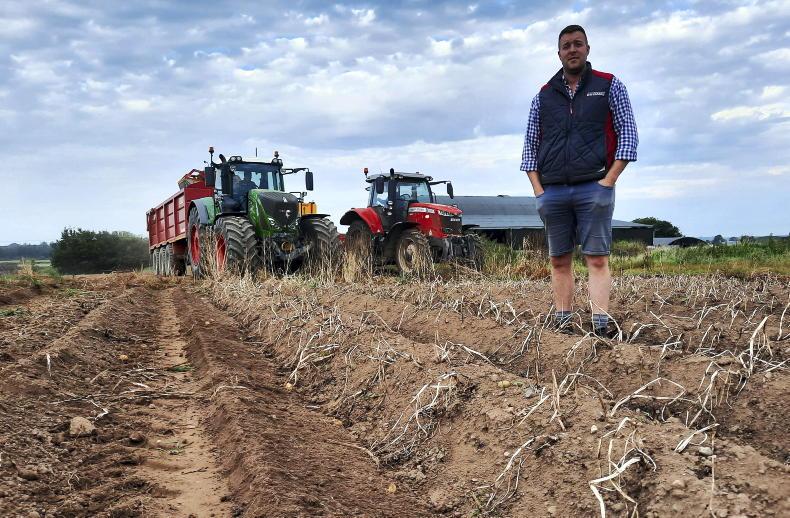




 This is a subscriber-only article
This is a subscriber-only article










SHARING OPTIONS: